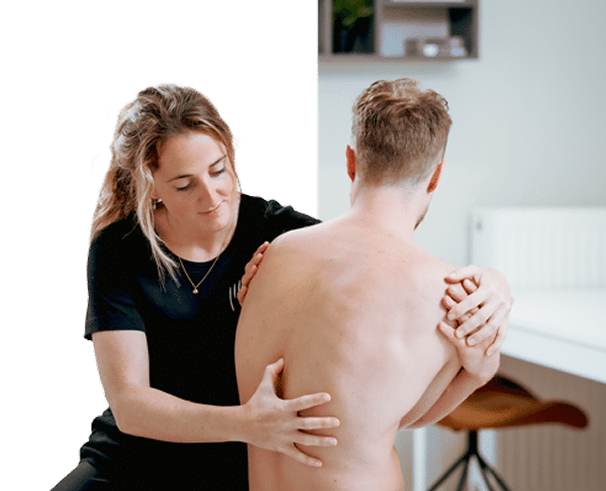What are buttock complaints
Buttock complaints are physical discomforts in and around the gluteal region. You may feel pain in the gluteal muscles such as the gluteus maximus and gluteus medius or around deeper structures such as the fascia and the small muscles around the hip joint like the piriformis. The pain can remain local or radiate to the lower back, hip, or thigh.
Symptoms of buttock complaints
- Pain in the buttocks during movement or at rest
- Stiffness after sitting or when getting up
- Pressure pain during prolonged sitting or cycling
- Radiation to the lower back or thigh
- Pain when climbing stairs, squatting, or running
- Tingling or burning sensation after training or a long workday
Do you recognize these signals? Have your complaints assessed in time. Early intervention accelerates recovery.
Causes of buttock complaints
Buttock complaints often have multiple causes combined. Prolonged sitting puts pressure on tissues. Rapid build-up with glute exercises in the gym can cause overuse, such as hip thrusts, squats, and leg presses. Running on hard surfaces or hills also contributes. Lower back pain radiating to the buttocks can indicate irritation of nerve roots from the lumbar spine. An irritated tendon on the outside of the hip may cause pain felt in the buttocks. During pregnancy, changes in pelvic and hip load can trigger buttock pain. Sometimes a small irritation of the piriformis causes nerve pressure toward the leg.
What you can do yourself
- Keep moving within pain limits and alternate sitting, standing, and walking.
- Start the day with gentle hip and trunk mobility and take short walks during the day.
- Temporarily reduce squat and leg press volume and prioritize technique over weight.
- When training glutes in the gym, choose controlled repetitions with focus on hip hinge and stable pelvis.
- Wear breathable, well-fitting sportswear. Tight leggings may cause friction and irritation.
- If the pain persists or worsens, schedule an intake.
Treatment of buttock complaints at De Fysio Man
Our physiotherapists specialize in treating buttock complaints. We provide a personal and goal-oriented approach. We start with an intake and analysis of your complaints, activities, and training habits. We test hip mobility, gluteus medius and maximus strength, trunk and pelvic control, and assess your squat and hip hinge technique.
A treatment plan usually includes:
- Targeted exercise therapy for hip and trunk strength, stability, and coordination.
- Mobilization techniques for hip, pelvis, and lower back where needed.
- Technique advice for squats, hip thrusts, and leg presses with clear pain limits.
- Progressive walking and sports program with measurable milestones.
- Lifestyle advice for posture, sitting breaks, and recovery.
Our goal is for you to move freely and pain-free again with strong, resilient gluteal muscles.
Sports and training without setbacks
Training your glutes in the gym remains possible with smart build-up. Start with low intensity and perfect technique. Training for rounder glutes requires consistency and good execution. How to train your glutes safely? Work from basic patterns such as hip hinge, split squat, and controlled hip thrust. Add heavier loads later, such as BBL-inspired volume programs or intensive superset combinations. Use variation in grips and foot stance and monitor pelvic alignment with every repetition. How to grow bigger glutes without pain? Combine progressive resistance with sufficient recovery and mobility.
Skin and soft tissues around the buttocks
Not every complaint in the buttock region comes from muscles or tendons. Itchy bumps on the buttocks may indicate friction, folliculitis, or a fungal infection. Red bumps or large pimples may occur with acne on the buttocks. Chafing is often caused by friction and sweat in tight leggings. Stretch marks on the buttocks usually occur due to rapid growth or load changes and are harmless. Fungal infections may require treatment cream via a doctor. Hives can flare up suddenly, causing itchy welts. A lump between the buttocks can be due to irritation in the skin fold. Inflammation or acne on the buttocks may require medical care, especially with fever or rapid spread. Chickenpox in children causes blisters and itching on the buttocks. Herpes or impetigo in the buttock area are contagious conditions requiring medical attention.
Clothing and aids
Leggings for the buttocks can offer comfort in the gym, but choose breathable material and the right size to avoid friction. Butt-lifting shorts can provide temporary support but do not replace targeted training. Choose clothing that supports rather than hinders your technique.
Cosmetic procedures and trends
Buttock lifts, fillers, liposuction, or BBL are cosmetic procedures. They change the shape but do not solve the causes of pain. Vacuum therapy buttocks reviews vary, and scientific evidence is limited. For complaints, stick with a plan that builds strength, mobility, and load tolerance. Always discuss medical choices with a doctor.
Buttock complaints during pregnancy
Buttock pain during pregnancy often occurs due to changes in pelvic and hip load and hormones that loosen ligaments. Gentle stability exercises, shorter walks, and advice on sitting and lying can help. We tailor your plan to your trimester and daily activities.
When immediate help is needed
- Sudden severe pain with numbness or weakness in the leg.
- Fever or rapidly increasing redness and swelling in the buttock region.
- Severe back pain radiating to the buttocks with signs of paralysis.
- Uncertainty about wounds, blisters, or rashes that spread.
In these cases, contact your doctor immediately or call us for advice.
Frequently asked questions
Can you keep training with buttock complaints
Yes, if the pain remains mild and recovers quickly. Temporarily lower the weight and repetitions. Focus on technique and control. Then build up gradually.
Are squats and leg press safe
Yes, with proper technique and appropriate load. Keep your trunk stable, let your knees follow alignment, and avoid deep angles that cause pain. If you feel more discomfort the next morning, the stimulus was too high.
What helps against skin irritation on the buttocks
Choose breathable sportswear, shower after exercise, and dry the skin thoroughly. For itchy bumps or fungal infections, medical assessment may be necessary.
How to get bigger glutes without pain
Follow a program with progressive resistance, two to three sessions per week, and enough recovery. Combine hip thrusts, split squats, and controlled squats. Quality of repetitions comes before quantity.
Your next step
Do not keep living with pain or discomfort. With targeted treatment and personal guidance, you will work on recovery and stability. Together, we address the cause and build safely toward your goals.
Schedule an appointment now at De Fysio Man and work with us on strong and pain-free glutes.
Share this article:


